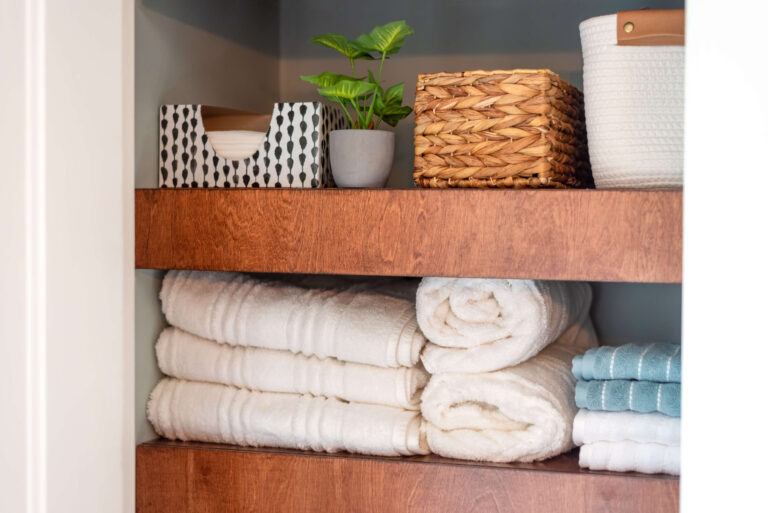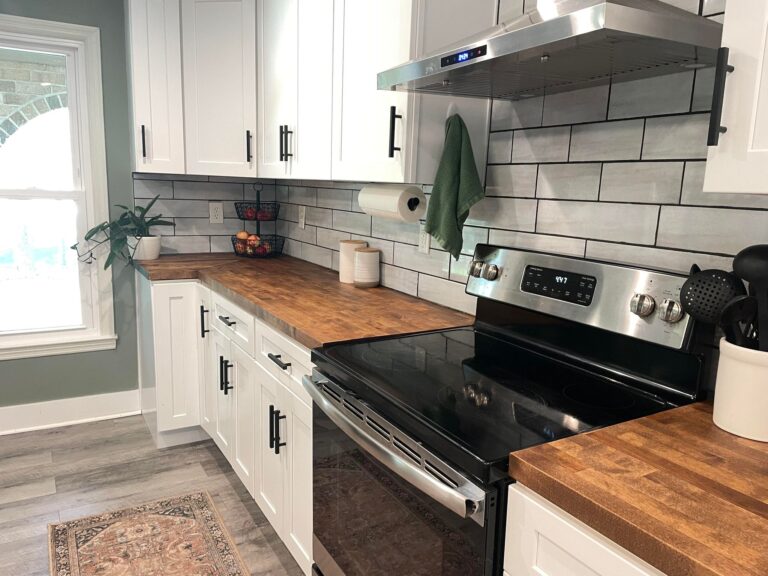Read This Before You Install A Second Story Window Box
Our Tips For Installing A Second Story Window Box: Read This Before You Start!
As part of our never-ending quest to find ways to improve the curb appeal of our split-level home, we recently installed flower boxes under our second floor windows. I’m obsessed with them! The colorful flowers and pretty white planter boxes really do add a lot to the otherwise plain two-story section. I also bought four white planter boxes for under our front porch arches, which I’m hoping will tie the two sections together.
As a side note- trying to find advice and inspiration on how to update a 1970s tri-level house with four brick arches along the front porch is “surprisingly” hard- there just isn’t a lot of this architecture on Pinterest. So I feel like I’m paving the way for the *maybe* three other homeowners with this dilemma.

*When you buy something from our affiliate links, we may make a small commission — but it never affects your price or what we recommend.
Turns out, attaching window boxes to a 2nd story window is not as straight-forward as adding to a 1st floor window- not just because it involves a ladder! This might be obvious to you- but for me it wasn’t anything I thought of beforehand. We did have to make some adjustments.
What size window box do I need?
First of all, you have to figure out what size planter box you need. A good rule of thumb for this is to measure the width of your windows and then add a little length on each side. Its better to go too long than too short. If you have shutters, you don’t have to extend the window boxes out to that length- you can, but you don’t have to. Here’s a couple examples of different ways to do it:


Types of Window Boxes:
Our window boxes are made out of a type of vinyl, and are fairly light given their size. Other window boxes are made out of composite material, wood, metal and fiber-lined wire.
Regardless of the material, you need to make sure your window boxes have drainage holes and are self watering. They need to get enough water without getting waterlogged.
DIY vs Bought Planters
We generally like to DIY just about everything, so I thought a lot about making our own planters. But, we have approximately two thousand other DIY projects we either are already currently in the middle of or have planned, so we decided this was not the time or place to try to be creative.
Our windows are six feet across, and we found these planters on Amazon that fit perfectly. Even more exciting is that I was able to find a “used” planter for half the price. When it came, I literally could not tell the different between the used product and the brand new one. They were both in great condition!
type of hardware

There are a few different styles of brackets- some are adjustable and will fit different sizes. But, most window boxes will come with some type of bracket.
Our window boxes have decorative brackets that go over the black brackets. At $27/each, we decided to pass on those. We had 10 brackets altogether and it would be WAY too much extra money to add a purely decorative accessory. However, if you’re willing to spend the money, or are installing a really small window box with minimal brackets, then decorative brackets can be a really nice look.
You will need construction screws. If you’re attaching your window box to brick, you’ll need a concrete/brick screw versus attaching to siding. We have a lot of brick on our house, but this particular section is siding. We were able to use regular screws.
So, let’s discuss the best way to install a second story window box
Measure Your Windows
Measure the width of your windows, taking into account any trim you have around the window and if you want to go under shutters.
Build or Put Together your Window Boxes
Our window boxes were really easy to put together. They came with glue, which we applied to the parts that clip/slide together, and then the sides and bottom snapped together.

Daniel also added additional construction adhesive to the internal seams of the window box just to ensure they were really secure. We don’t need these things collapsing and falling down on anyone’s head (no one we’d invite over to our house, anyway).
Gather Your Tools and Materials
To install a second story window box, you will need the following tools and materials:
-Window box
-Brackets or supports
-Back board the size of the back of your window box (We used a 2×8)
-Saw to cut back board to correct length
-Screws (concrete screws if drilling into brick)
-Drill and drill bit
-Level
-Pencil
-Tape Measure
-Ladder
-Spray paint (optional)
-Siding paint (optional)
Paint Back Board And/Or Brackets
This is important for a second story window box: we recommend painting the back board the same color as your siding. If you don’t have the siding paint color, make your board smaller than the window box (but not too small!) so that it can’t be seen from under or to the side of the boxes.
Also, paint your brackets the same color as your window box, if they don’t come that way (most are black). When we installed the first window box, we realized the board and brackets were really visible. This wouldn’t be a problem on a lower window, but with the boxes being up high, the bottom and sides can be seen clearly and the black brackets really stood out.
I think we can all agree this looks terrible:

A simple solution for the brackets was to spray paint the hardware to match the window box:

And then we painted just the parts that could be seen for the board:

Install A Back Board

We installed a 2×8 board onto the siding to have something to provide additional support and stability to the window box. It also helps distribute the weight evenly.
We used a board that came on a pallet for our pool deck materials and simply cut it slightly shorter than the length of the box- approximately 2″. Daniel attached the board using 3″ construction screws with a T-25 Star Drive head. We figured out (or tried to, anyway) where the studs were, and put screws in along the length of the board.
Tip: We prefer using T-25 Star Drive screws instead of Phillips. T-25 have a better grip to the bit and its easier to put them in without stripping them out. Phillips tend to strip out easily and require a lot more force installing them into solid wood (which is dangerous up on a ladder!)
As I previously mentioned, we ended up painting the board. We cut the board to fit the dimensions of the window box exactly, and didn’t take into account that it would be seen from below and the side. Once our first window box was installed, we realized we need to paint it to blend into the siding.

We chose to remove the window box and paint the board. For the other window, we painted the board AND made it slightly smaller, so that it wouldn’t be seen.
Tip: When doing projects on older houses, things may have settled and/or shifted over the years (or maybe not installed correctly to begin with) and may not be level. To work with this, it may be more aesthetically pleasing to match the existing slope. We matched the slope of our siding and window seal instead of making the window boxes match what was shown on the level.
Attach The Brackets to the Back Board
Our particular window boxes came with five brackets. There are beautiful decorative brackets that are sold separately, but at over $27 each, we decided to pass.
The directions for our window boxes said to place the top of the brackets 3″ below the bottom of the window sill. We placed the top of our brackets slightly less than 3″ below the window sill, but we had determined we liked this placement best and it covered the very bottom of the window trim.
Tip: Before installing all of the brackets, install a bracket on each end for the window box, then set the window box in place. See how you like the elevation- then install the other brackets.
Use a level to make sure the brackets are level with each other and also level with the window. Unless you have an old house like we do, and then you may just want to follow the slope of the window.

To determine how far apart to install the brackets, install each end bracket first. Then measure the distance between the two brackets, and divide by the number of brackets left to install, plus one. Take that measurement and make a mark for each bracket (an on-center measurement.) This is where the screws will go for each bracket.
For example, if you are installing five brackets, you’ll install the two on each side, and then measure in-between. Take that measurement, divide it by four, and use this measurement to mark where to install the screws for the remaining three brackets.
Our window boxes slid right into the brackets easily. Here they are, installed!

What To Plant in Your Second Story Window Box
After the window boxes were installed, I added the potting mix and flowers. I planted everything by leaning out the window- no scary ladders for me!
These boxes are really large- over 6 feet- so they took a lot of potting mix and flowers! To cut down on the amount of soil I needed to buy, I added a bunch of aluminum cans to take up some space.

Tip: Lighten the overall weight of the window box by putting aluminum cans at the bottom of your planter. Make sure the cans are laying on their sides so they don’t fill with water.
I am developing a green thumb, but I still don’t trust myself with keeping many flowers alive for several months. And, I don’t want to have to buy new plants every season! So, I went with a mixture of real and fake flowers and plants.

Because of the roof overhang, I had to find plants that would thrive in a shady window box. I went with impatiens and begonias as well as fake plants.
Just make sure if you’re planting your window boxes in full sun that you take that into account- your plants need to be able to handle the light conditions.
I bought these trailing plants, wheat grass, and red geraniums from Amazon.

This is my spring window box- I’m exciting to switch things out for fall and winter and play around with different combinations!
Our home’s exterior is always a puzzle, but we are slowly getting there. Adding a second story window box under each upper window helped dress up the front of the house a lot. Now we can’t wait for our landscaping to mature and fill in!

Looking for outdoor project ideas? Check out our post about painting a concrete patio!







